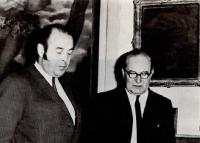SLOVENSKI SLOG: EVROINTEGRACIJA IN NIHILIZEM
Slovenci se od drugih južnoslovanskih narodov ločijo po tem, da je njihova identiteta najmanj vezana na jasno izražen politični, zgodovinski ali religiozni projekt. V nasprotju s pravoslavnimi Bolgari in Srbi Slovenci ne poznajo bizantinske ideje katehona,2 se pravi imperija in neodvisnega patriarhata, ki bi nase prevzela misijo, podobno Bizancu. V nasprotju s (prav tako) katoličani Hrvati, s katerimi so si kulturno najbliže, so tudi precej slabo razvili idejo o oblikovanju močne, neodvisne slovanske oziroma nacionalne države. Hrvatje so sanjarili o obnovitvi kraljestva Trpimirovićev in si prizadevali za utrditev religiozne samobitnosti, kar se je izrazilo tudi v uporabi glagolice v bogoslužju. Slovenci so ponižno sprejeli latinščino, z vprašanjem o bogoslužju v nacionalnem jeziku so se ukvarjali šele v času protestantizma (v marsičem pod vplivom Čehov).




